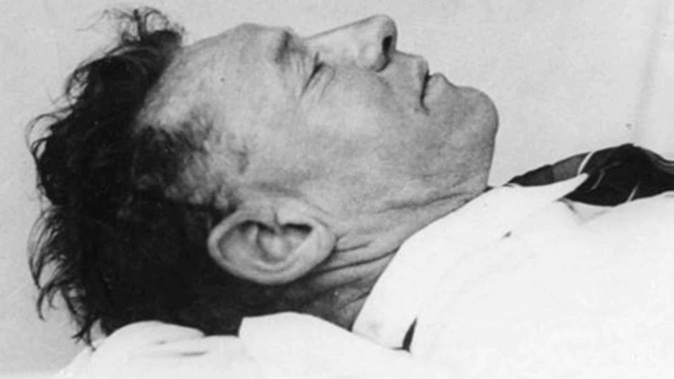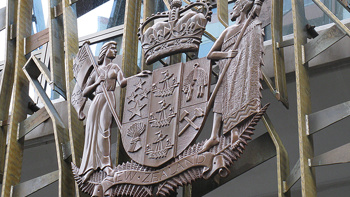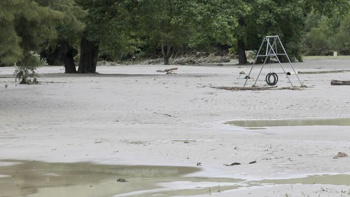
Warning: Graphic content
One of Australia's greatest mysteries may finally be solved after a professor came forward claiming to have identified a body found on a beach nearly 75 years ago.
The hauntingly intriguing case of the Somerton Man has baffled researchers for decades.
The man's body was found propped up against the seawall at Somerton Beach in Adelaide on December 1, 1948.
Inside his pocket were the printed words "Tamam Shud", which means "finished" in Persian.
He had an unsmoked cigarette resting on his chest, his hair was perfectly in place and his double-breasted jacket was pressed and in perfect condition.
All sorts of theories have been put forward over the years, including that the Somerton Man was a spy.
The body was exhumed last year in a fresh bid to crack the case.
/cloudfront-ap-southeast-2.images.arcpublishing.com/nzme/SL7X6AKXROF45UZ6NEVGQZBSXE.jpg)
The Somerton man, pictured after his death. Photo / Supplied
And now, 74 years after the Somerton Man was found, Professor Derek Abbott from the University of Adelaide says he knows who he was.
He claims to have identified the man as Carl "Charles" Webb, from Melbourne.
Prof Abbott that Webb was born on November 16, 1905, making him 43 when he died.
He is said to have worked as an electrical engineer, the Advertiser reported.
He married Dorothy Robertson, who became known as Doff Webb. He left her in April 1947.
"He disappeared and she appeared in court, saying that he had disappeared and she wanted to divorce," Colleen Fitzpatrick from Identifiers International said.
By 1951, she had moved to Bute in South Australia, raising the possibility that Webb had come to find her.
The forensics experts used hairs taken from a plaster 'death mask' to analyse his DNA.
They used that DNA to build an extended family tree, and were finally able to identify the Somerton Man as Webb.
Webb has no death record.
/cloudfront-ap-southeast-2.images.arcpublishing.com/nzme/SAKBSM4DGUY2MQT44ZCDAPEX5Y.jpg)
Wellington-born Rachel Egan may be the granddaughter of the Somerton man. Photo / Supplied
"By filling out this tree, we managed to find a first cousin three times removed on his mother's side," Prof Abbott told CNN.
"It just felt like I climbed and I was at the top of Mount Everest."
Fitzpatrick added: "It's like one of these folklore mysteries that everybody wants to solve and we did it."
South Australia Police said there were no updates to the case.
In many ways, the potential discovery of the identity of the Somerton Man raises more questions than answers.
The police discovered a number of unusual items on his person back in 1948.
A half-eaten packet of Juicy Fruit was uninteresting, but an aluminium comb, a product unavailable in Australia, suggested he had been in America recently. His clothing was also of an American brand, as police later discovered.
An Army Club cigarette packet in his pocket contained a number of cigarettes of another brand. This in itself wasn't unusual: at the time it was fashionable to carry the case of an expensive brand of cigarettes while refilling it with a cheaper brand. Police noted, however, that the Somerton Man did the opposite of this, filling the cheap packet with expensive cigarettes. This struck them as oddly deliberate as if he was trying to play himself off as being of a lower class.
An unused rail ticket from Adelaide to nearby Henley Beach and a bus ticket from the city led police to the train station, where they discovered a suitcase that was assumed to belong to him.
The case contained a number of items, including clothing that had all the tags and identification cut out of them.
Three shirts had the name "Keane" written in: police believed these were either overlooked by whoever cut out the names or left intact as a red herring. Either way, they quickly ascertained Keane was not the man's name, as no missing persons with that name were reported.
He carried no wallet, his shoes were unusually clean considering he had been walking on a beach, and his hands and nails "showed no signs of manual labour".
/cloudfront-ap-southeast-2.images.arcpublishing.com/nzme/56JSHJHGMIQGQVFAN35EKPZFE4.jpg)
Items found in a suitcase belonging to the Somerton man. Photo / Supplied
His autopsy revealed a number of abnormalities that suggested he had been poisoned.
The findings read in part: "There was blood mixed with the food in the stomach. Both kidneys were congested, and the liver contained a great excess of blood in its vessels … The spleen was strikingly large … about three times normal size … there was destruction of the centre of the liver lobules revealed under the microscope … acute gastritis haemorrhage, extensive congestion of the liver and spleen, and the congestion to the brain."
Despite these findings, no poison was found in the man's body, and the usual reactions to such a thing - vomiting and convulsions - were not evident. If he was poisoned, it was a fast-acting type, undetectable to medical science at the time.
A small rolled-up piece of paper was found in his pocket, which read "Tamam Shud", Farsi for "it is ended" or "finished".
The jagged paper was soon discovered to have been ripped from the final page of The Rubaiyat of Omar Khayyam, specifically a 1941 edition.
The book was a translation of verses by an 11th-century Persian poet, and was popular in the Western world during the 1940s.
Police launched a nationwide appeal for information on the book with the missing page and, surprisingly, a man came forward claiming he found the book on the back seat of his vehicle, which was parked at Somerton Beach around the time of the man's death.
He often left the windows of his car open and thought little of it until he read about the search in the paper.
The book itself revealed a startling clue on the back page: an encrypted message, five lines long, each with nonsensical strings of letters. The second line is struck out, adding to the mystery.
/cloudfront-ap-southeast-2.images.arcpublishing.com/nzme/VUR726V4LRL4D2DVXRFX7WIGIQ.jpg)
Code found in book believed to be linked to the unknown man found dead on Somerton beach. Photo / Supplied
Code-crackers from the Federal Bureau of Investigation and Scotland Yard were tasked with decoding the message, but this came to nothing.
Given the man's "top physical condition", as described by the coroner, the secret code, undetectable poisoning, the fact that nobody could identify him and the "Tamam Shud" note, theories emerged that the Somerton Man was a Russian spy.
Take your Radio, Podcasts and Music with you









